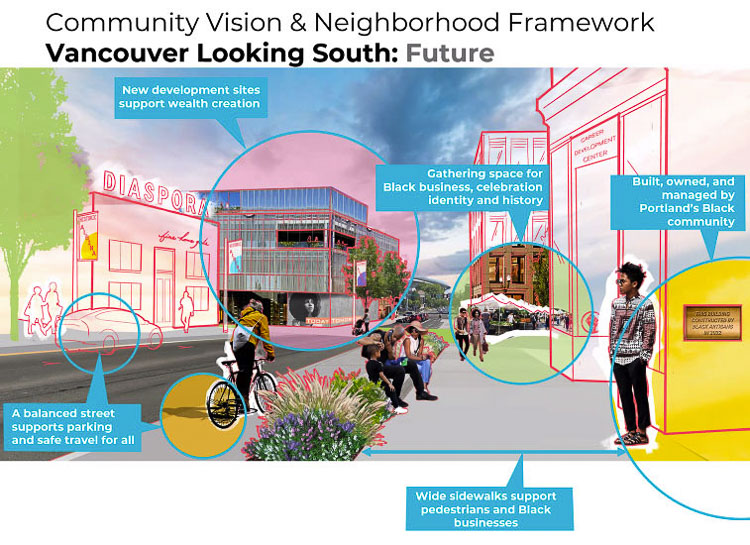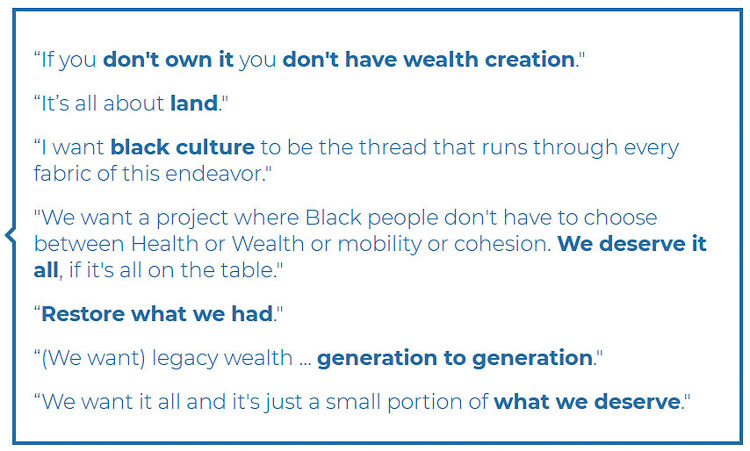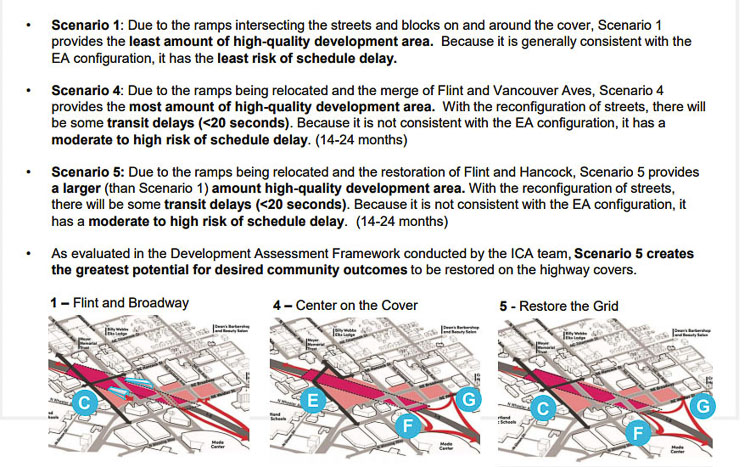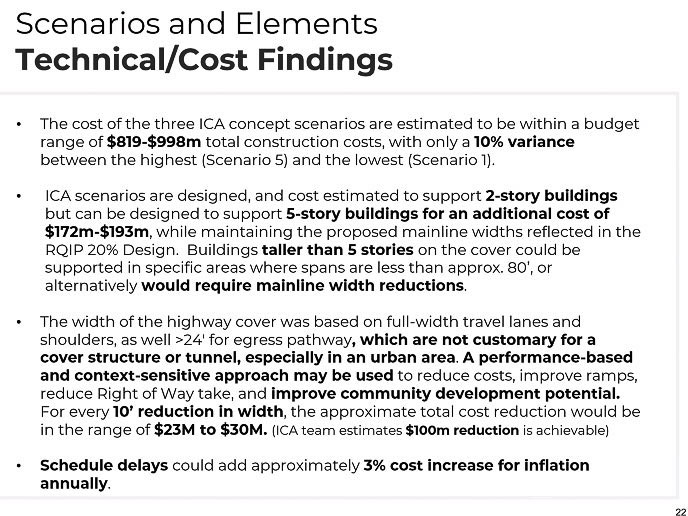Decision on freeway covers delayed as overall timeline faces likely 14-24 month delay
In the past few months, the I-5 Rose Quarter project has encountered several potholes. The Oregon legislature began the project four years ago as part of the HB 2017 transportation package. Originally $450 million was allocated to the project. It’s now approaching $1 billion.
Portland politicians quickly began selling the transportation project as more — “it’s a community redevelopment project” people were told. There would be two small caps over I-5, creating real estate. There was talk of “equity” and “restorative justice” in many, many community discussions. A committee on “equity” and a broader “community” committee were created by the Oregon Department of Transportation (ODOT) to ensure local input.
But early on, the anti-car and the “no more freeways” groups joined the climate change crowd to oppose the “expansion” of I-5 at this known bottleneck. It is the only two-lane section of I-5 in an urban area from Canada to Mexico.
The “no more freeways” effort has a five-decade track record of successfully opposing new transportation projects, starting with the Industrial Freeway (I-505) in northwest Portland, and the Mt. Hood Freeway in the 1970’s. A history can be viewed in the Remnants of Portland’s Unbuilt Freeways documentary.
This is of interest to Southwest Washington citizens for many reasons. First, roughly 75,000 Clark County and Southwest Washington residents work in Oregon, crossing the two bridges over the Columbia River. Those commuters are mired in traffic congestion as part of the nation’s eighth worst traffic congestion. Drivers have routinely expressed that they want improved travel times, most of all. Traffic congestion relief tops all local surveys on transportation on both sides of the river.
In that same Oregon HB 2017 was authority for ODOT to “study” tolling both I-5 and I-205 “at the border” with Washington. Four years later, ODOT speaks about using some of that tolling revenue to pay for the Rose Quarter project. A large portion of I-5 toll revenue in the project area could be paid by Southwest Washington residents.
ODOT’s original cost estimates have risen sharply. A revised price tag became $795 million as ODOT officials failed to factor in inflation for construction in the future. ODOT now has to find the funds for the “cost overrun” even before there is a specific project.
Almost a year ago, the Albina Vision Trust expressed discontent with ODOT and its process for community involvement. They withdrew, triggering the Portland City Council and the mayor to withdraw their support for the project. Multnomah County and Metro also withdrew their support a short time later.
Portland Public Schools expressed concerns over the widening of the freeway and its potential impact on Harriet Tubman Middle School from the beginning. Tubman was opened in 1982, but the location had served the community as Eliot Elementary School since 1952. The school district shut it down in 2012 due to low student enrollment, but reopened it in 2018 (after passage of HB 2017).
According to one news report, fewer than 500 students attended the school in 2018. Forty percent of the students were black.
Opposition from school supporters has grown more intense recently.
The Portland bicycle community expressed displeasure over the removal of the Flint Ave. overpass, in spite of ODOT originally proposing a $30-$50 million exclusive bike and pedestrian overpass near Clackamas St.
“Freeway expansions are not going to get us to our climate goals,” said Jo Ann Hardesty, a Portland city commissioner. “In fact, freeways are a thing of the past.”
How many lanes?
The original project left the Rose Quarter with two through lanes in each direction. The plan was to simply expand the length and location of current “auxiliary lanes” to facilitate traffic getting on and off I-5. ODOT promised the extended auxiliary lanes would reduce accidents by 30-50 percent on Oregon’s most accident-prone section of freeway.
But late this spring, ODOT graphics surfaced showing a variety of configurations. A map obtained by No More Freeways PDX showed significantly more lanes than were originally discussed. This would be welcome news to freight haulers and people mired in traffic jams.
But it raised the alarm for those opposed to cars in general because it provides more vehicle capacity. “This is history continuing to repeat itself,” said Aaron Brown, a spokesperson with No More Freeways PDX. “The North Portland neighborhood has dealt with systemic racism and redlining and environmental injustices for decades.”

One graphic published in Willamette Week showed two 12-foot shoulders for each direction of travel, giving the appearance of five vehicle lanes in each direction.
Joe Cortfight at his City Observatory website said the following.
“For years, the Oregon Department of Transportation has been lying about the freeway widening project it plans for a mile long stretch of I-5 at Portland’s Rose Quarter. While it’s advertised as just adding a couple of so-called “auxiliary” lanes, we and others have uncovered multiple documents showing that they’re actually planning a 150-foot to 160-foot roadway, wide enough for a ten lane freeway.”
ODOT officials have said it wants to build 12-foot shoulders along the existing highway so that buses can travel unimpeded in the center of I-5, in addition to safety requirements.
The idea caught some officials by surprise, including a representative of TriMet.
“Frankly, two minutes before this meeting, my team gave me a heads-up that this interior 12-foot bus lane was going to show up,” Steve Witter said at the March 22 meeting. Witter is the TriMet representative on the Executive Steering Committee (ESC) for the project. “I’m not sure why this is there. We don’t operate a bus-on-shoulder.”
C-TRAN, Clark County’s transit agency, does. TriMet rarely runs their buses on interstate highways.
“That’s a 10-lane freeway; you can call those lanes whatever you want, but it’s still a 10-lane freeway,” says Cortright, a vocal opponent of the project.
Yet in May, the Oregon Transportation Commission (OTC) voted for 12-foot shoulders on both the inside and outside of the project, and a new 12-foot auxiliary lane in the center of the highway according to one news report.
A June 2 cost report estimates covering the highway would cost more than $500 million. Covers that could support five-story buildings would cost roughly $200 million more, depending on which design moves forward.
Historic Albina Advisory Board
Over two years of promises to “heal” the divisions caused by locating Interstate 5 through the middle of the old Albina neighborhood has brought hope, optimism, and now scepticism by many leaders in the black community. The construction of I-5 is reported to have destroyed over 300 homes in the Albina neighborhood.
Initially it was the Albina Vision Trust that withdrew support. ODOT created the Historic Albina Advisory Board (HAAB) to fill the void and provide a voice for the minority community.
At a three-hour May 18 combined meeting of the HAAB, the ESC and the Community Oversight Advisory Committee (COAC) all met and shared concerns. This was the first time all three committees had met together. Members were told to “speak your truth” and they did.
The 38 members were presented five options for the covers over I-5, creating real estate and a variety of options to begin knitting back together the Albina Community.
But the unity and nice words began to fall apart.The talk of creating “unity” and “equity” and “generational wealth” to right the historic wrongs was falling on deaf ears, according to many of the participants.
James Posey was unhappy. Not enough was being done to fix decades of injustices to the black community. Nate McCoy spoke about there not being enough black people involved in the process. He was concerned that all the discussion about “creating future generational wealth” for black Portlanders was just talk.
Michael Burch spoke about all the murders currently happening in the black community. Keith Edwards felt environmental health was not getting the proper attention it needed.
Pastor Matt Hennessee was originally excited about the project. He’s an optimist. But on May 18 he became “a bit disturbed.” People from the community stated Options 4 and 5 are very important, but ODOT appeared to be pushing something else.
ODOT’s response indicates “your opinions mean nothing” according to Hennessee. “You were doing a good job telling us about why we shouldn’t have Options 4 and 5, instead of why Options 1, 2 or 3 were better.”
“ODOT — tonight, this does not help your credibility problem,” he said. Earlier Hennessee claimed ODOT’s credibility was “razor thin.”
Rose Quarter project director Megan Channell responded to Hennessee. “You are right, we are in a trust deficit.”
John Washington needed to know about “ownership” and get a better understanding of how this project was going to create more business opportunities. “We’ve been getting our asses kicked for a long time,” he said.
He spoke about the killings and murders in the community. “People have lost their jobs and their homes,” Washington said. “There is a lot of stress in the community.”
“People doing construction work understand the racist nature of what’s happened to us,” Posey said.. “It hasn’t changed that much.” He closed by saying it’s hard to do construction work anywhere as a black person.
Posey feels “the stars are aligned” and will never be like this again, mentioning Alando Simpson, a black member of the OTC. “This is a once in a lifetime thing,” he said. “If we don’t get it now, we may never get it.”

A week later at a May 24 joint HAAB and ESC meeting, Simpson began the meeting discussing what had happened the week prior. “There’s 30 minutes of conversation that went on. (I’m) not sure it went in a stable direction. I mean, because there’s just a lot of opinions. So it’s really hard to get everybody on the same page.”
Simpson tried to focus the group. “The other thing that I mentioned at the end was that there’s a big elephant in the room,” he said. “That elephant comes with a big bag of cash. I know this makes people very uncomfortable talking about money, especially people who have a lot of money. But the reality is the people who don’t have a lot of money, i.e. the black community in Portland, Oregon, need to understand and is owed the freedom and space to understand, how the dynamics of capital will work on this project.”
Project staff shared additional input from two community open house events regarding the covers and the project. They received very little written feedback, so they had to rely on verbal comments.
“We want a project where black people don’t have to choose between health or wealth or mobility or cohesion. We deserve it all, if it’s all on the table.”
Another citizen’s input: “We want it all – and it’s just a small portion of what we deserve.”
The community wants to “build it, own it, and benefit from it in the future.” This would require a separate, unique form of governance to be created. Apparently federal law does not allow private individuals or entities to own the land on a freeway cap. It can be leased, with private parties owning the structures they build on top.
Simpson shared again, “this is a once in a lifetime opportunity.”
HAAB member Keith Edwards wanted to understand the ODOT definition of “minority.’’ “Too often, we as African Americans, when we’re supposed to be the target of benefits, we end up being the last in line,” he said. “We don’t get our due share and we get left behind again.”
The Five Options
Originally there were two smaller “caps” proposed over I-5 in the project. The OTC directed ODOT to create an Independent Cover Assessment (ICA) team. Multiple meetings and community involvement have produced five options, two of which are most strongly supported by the Albina community.
All scenarios now have one larger cover over I-5. This creates a “tunnel” according to federal highway standards, with added requirements for ventilation, lighting, and safety.

Options 4 and 5 have the largest expansion of the cover over the interstate, creating the most real estate and perceived opportunity. According to the briefing, ODOT believes the covers can support buildings of two stories. Taller buildings would require thicker caps for the freeway, raising the height of the caps and the connecting roads.
One report indicates the larger caps could cost $500 million. More significantly, the larger caps and revisions in options 4 and 5 could likely cause a revised environmental assessment (EA) to be accomplished under the NEPA process, delaying the project by several years. That triggered a very negative reaction.
The ESC met June 28 getting an update on the project. From that meeting it appears the mid July time frame for the OTC to get a recommendation on the caps and scope of the project has been pushed back to September.
The staff had pared down the original five options to three scenarios for the ESC to consider. The process timeline has also been adjusted, where the ESC will have three more meetings before a final recommendation will be made.
- Scenario 1: Due to the ramps intersecting the streets and blocks on and around the cover, Scenario 1 provides the least amount of high-quality development area (6.79 acres). Because it is generally consistent with the EA configuration, it has the least risk of schedule delay.
- Scenario 4: Due to the ramps being relocated and the merge of Flint and Vancouver Aves, Scenario 4 provides the most amount of high-quality development area (8.96 acres). With the reconfiguration of streets, there will be some transit delays (<20 seconds). Because it is not consistent with the EA configuration, it has a moderate to high risk of schedule delay. (14-24 months).
- Scenario 5: Due to the ramps being relocated and the restoration of Flint and Hancock, Scenario 5 provides a larger (than Scenario 1) amount of high-quality development area (8.21 acres). With the reconfiguration of streets, there will be some transit delays (<20 seconds). Because it is not consistent with the EA configuration, it has a moderate to high risk of schedule delay. (14-24 months).
As evaluated in the Development Assessment Framework conducted by the ICA team, Scenario 5 creates the greatest potential for desired community outcomes to be restored on the highway covers.
Staff reported the HAAB had met the previous week and supported scenarios 4 or 5, whereas members of the ESC who participated voiced more support for scenario 1.
ODOT’s Brendan Finn, shared he has significant concerns about the project’s potential impact on Madrona Studios, a five-story building with facilities to help the homeless located on Weidler St.
McCoy expressed concerns about the accuracy of the alleged 14-24 month delay being mentioned, when on a national level, delays due to changes in the environmental statement average three-to-five years.
Staff briefed there would be no additional cost for the covers to support buildings up to two stories in height. Buildings of three to five stories would likely require an additional expenditure on the covers of $172 million to $193 million.
The cost of the entire project is now estimated to be between $819 million to $998 million, with a 10 percent variance between the cost of option 1 versus option 5. These cost estimates are based on the January 2020 “cost to complete” report from ODOT. There have been important changes since then which will likely change cost estimates.
Staff shared that for every 10-foot reduction in width, the approximate total cost reduction would be in the range of $23 to $30 million. (The ICA team estimates a $100 million reduction is achievable).

The width of the highway cover was based on full-width travel lanes and shoulders, as well 24 feet for an egress pathway for safety response, which are not customary for a cover structure or tunnel, especially in an urban area. However it was mentioned that both federal and state standards for shoulders are 12 feet per shoulder.
Responding to a question about why not smaller shoulders for the tunnel under the lid, the staff indicated a desire for flexibility to include a transit element for Bus On the Shoulder (BOS) in the future. Only C-TRAN currently runs BOS operations.
Late in the meeting, staff member Kate White spoke about the potential for delays in the project. “We need to get real about the risks that the Rose Quarter Improvement Project as currently proposed is facing,” she said. “That’s not reflected in the current schedule. So there’s major political risks with the current proposal, when you don’t have the city on board, you don’t have a lot of the community on board.”
That triggered an immediate response from Dr. Steven Holt who was moderating the meeting.
“So Kate, when you said there isn’t a lot of community on board, that’s not an accurate assessment,” he said. “That’s an assessment or perspective, but to make a determination on that is not an accurate way to represent that. So I really want you to be careful on how those things get represented.”
It would appear that the width of the freeway underneath, already approved by the OTC, allows for maximizing the area on the covers for the hoped for “restorative justice.” The HAAB hopes for the maximum benefit possible, whereas the anti-car or no more freeways group is opposing any additional lanes.
Stay tuned
At the May 12 meeting of the OTC, the transportation reality of this project was acknowledged. “I-5 between Interstate 84 (I-84) and Interstate 405 (I-405) has the highest urban interstate crash rate in Oregon, is the state’s top bottleneck, and as of 2021 is the 28th worst freight bottleneck in the nation.”
The OTC directed ODOT to proceed with the project, to include a 22-foot-high noise reduction wall adjacent to the Harriet Tubman school. The total width of the freeway lanes and shoulders is not to exceed 146 feet.
The delay in the ESC making a recommendation to the OTC would appear to be to allow all the parties additional time to come together to support one plan. With nearly $1 billion in play, it is likely the divisions will be set aside with a recommendation to move forward with a project that includes a single, larger cover over I-5.
Some want covers to be as large as possible, so “the community” can make the most of this new asset and opportunity. Others want a smaller width, to accomodate fewer potential vehicles, and to stay farther away from Harriet Tubman school.
The freight haulers want more and wider lanes for both safety and traffic congestion relief. Most average citizens are tired of being mired in traffic congestion over 12 hours a day.
As Simpson said at the May 24 meeting, “there’s a big elephant in the room. That elephant comes with a big bag of cash.”
What the Rose Quarter project ultimately looks like and what the final elements will be, remains to be determined. Who will pay remains a concern, especially to the roughly 75,000 Southwest Washington citizens working in Oregon.





I would like to correct a factual error in this article. While it is true that the Portland Public School (PPS) building in question, Harriet Tubman Middle School, opened in 1982, the building had opened as an elementary school in 1952, 12 years before I-5 was built in 1964. The building has been in continuous operation as a school since 1952, except for a short period from 2012-2018. The 6-lane interstate freeway was built within 60 feet of the Eliot Elementary School, as it was known at the time. PPS has already spent at least $10 million on a state-of-the-art HVAC system to mitigate the impact of air pollution emanating from the freeway. The current proposed lane expansion would move the freeway to within 26 feet of the school, not only further deteriorating the air/noise quality for students and staff in the school, but also potentially jeopardizing the structural integrity of the building. This latest assault on the school perpetuates the legacy of the destruction of the Albina neighborhood, the historical hub of the African-American community in Portland.
Rita —
Thank you for the added information. The story has been updated to reflect the fact that Eliot Elementary School was at this location since 1952.
Eliot merged, and is now the Boise-Eliot/Humboldt elementary school at 6th and Fremont.
Mr. Ley:
Thank you for your thorough analysis of the I -5 freeway covers and other attempts ODOT has attempted to solve some of the traveling issues through the Portland metropolis.
As a native Oregonian of 75 years, I can recall vividly the attempts that were made for the Mt. Hood freeway which was shut down by those groups that were anit-expansion, As a member HAAB I believe you have given fair report on what has transpired over several years of meetings from the various teams and stakeholders on this project. HAAB has unsuccessfully tried to incorporate the Restorative Justice component to the discussions that have been overridden with vague inferrences regarding creating wealth and ownersihp to theproperties that would be constructed on the covers with favor to Black ownership.
As the meetings continue throught the summer months, the cost for this project continues to increase and delays for various reasons seem to moving toward the final outcome of the Mt. Hood freeway project. Without a true meeting of the minds of the stakeholders this project is destined to a very costly failure.
thank you for your report.
RichardProbasco